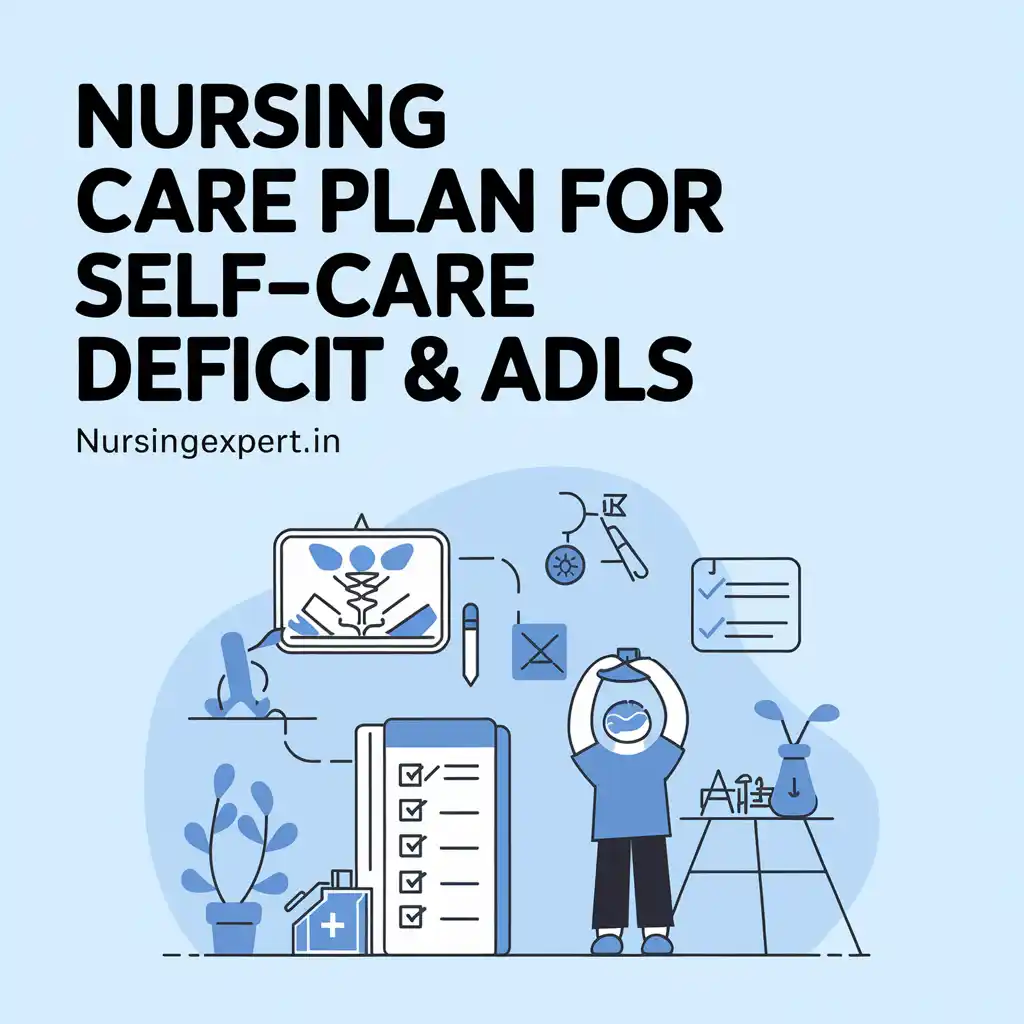Self-care stands as the foundation of daily living and well-being. Many patients, especially older adults and those with chronic conditions, face a self-care deficit when they cannot perform essential activities of daily living (ADLs). This care plan focuses on assessing these deficits and guiding nurses through targeted interventions that promote independence, safety, and improved quality of life. The following article outlines 10 essential nursing care plans that provide a step-by-step approach to diagnosing self-care deficits, designing effective interventions, and ensuring ongoing evaluation. A downloadable PDF version of the plan supports clinical practice and exam preparation.
Thank you for reading this post, don't forget to subscribe!
By following these structured plans, nurses gain a clear framework to work with patients who experience difficulty with tasks such as bathing, dressing, eating, and toileting. This guide empowers healthcare professionals with practical strategies, while also serving as a resource for academic and clinical settings.
Understanding Self-Care Deficit & ADLs
A self-care deficit refers to the inability to perform basic self-care activities independently. Activities of daily living (ADLs) include tasks such as personal hygiene, dressing, eating, toileting, and ambulation. This deficit can result from various factors including physical limitations, cognitive impairments, or environmental challenges.


Nurses play a critical role by first understanding the specific areas where the patient struggles. They use standardized assessment tools to measure the patient’s ability to complete each ADL. A thorough evaluation includes both subjective reports from the patient and objective observations. The collected data guide the development of a comprehensive care plan that focuses on restoring or enhancing the patient’s independence.
By defining clear goals and identifying measurable outcomes, the care plan helps reduce the risk of complications and fosters a positive impact on the patient’s daily living. This framework supports the patient’s journey toward self-sufficiency and a better quality of life.
Factors Affecting ADLs
Multiple factors affect a patient’s ability to perform ADLs, and understanding these is essential for tailoring nursing care plans effectively. The following factors are common in many patient scenarios:
- Physical Limitations:
Patients may experience muscle weakness, joint stiffness, chronic pain, or reduced range of motion. These limitations can arise from conditions like arthritis, stroke, or post-surgical recovery. Nurses must assess the extent of these physical challenges to set realistic goals. - Cognitive Impairments:
Cognitive deficits such as memory loss, confusion, or diminished decision-making capabilities hinder the performance of ADLs. Patients with dementia or other neurological conditions often need extra guidance and support. - Emotional State:
Emotional factors, including anxiety, depression, or low self-esteem, can impair the motivation and energy needed to engage in self-care. Nurses must address these issues with empathy and provide emotional support alongside physical care. - Environmental Barriers:
The layout of a patient’s living space can significantly influence their safety and ability to perform ADLs. Cluttered spaces, poor lighting, or the absence of safety features like grab bars increase the risk of falls and injuries. - Social Support:
The presence or absence of family, friends, or professional caregivers can determine the level of assistance available. Patients with robust social support may experience better outcomes, while those lacking support require additional resources and community services.
Each of these factors must be considered during the assessment phase to create a personalized care plan. Tailoring interventions to address both physical and non-physical challenges enhances the overall effectiveness of the nursing care plan.
Etiology and Risk Factors
Self-care deficits stem from various causes, and recognizing the etiology is vital for developing effective interventions. Below are common risk factors and causes:
- Advanced Age:
As people age, they experience natural declines in muscle strength, coordination, and cognitive function. This decline increases the risk of self-care deficits. - Chronic Illnesses:
Diseases such as arthritis, stroke, heart failure, and Parkinson’s disease can impair mobility and cognitive abilities. These conditions contribute significantly to the onset of self-care deficits. - Acute Medical Events:
Sudden events like injuries, surgeries, or severe infections may lead to temporary or permanent impairments. These events can significantly disrupt a patient’s ability to perform ADLs. - Mental Health Disorders:
Conditions such as depression, anxiety, and dementia affect not only emotional well-being but also the practical ability to manage daily tasks. Mental health issues can exacerbate physical limitations and delay recovery. - Lack of Social Support:
Patients who do not receive adequate support from family or community resources are at higher risk. Isolation and a lack of assistance can intensify self-care deficits.
Identifying the underlying causes helps nurses design interventions that target the root issues. By understanding risk factors, healthcare professionals can prioritize high-risk patients and introduce preventive measures early in the care process.
Signs and Symptoms
Early recognition of self-care deficits is critical for timely intervention. Nurses must be vigilant for the following signs and symptoms:
- Difficulty Performing ADLs:
Patients may show clear signs of struggle when engaging in activities like bathing, dressing, or feeding. They may require extensive assistance or exhibit unsteady movements. - Fatigue and Weakness:
A decline in energy levels and strength is common. Patients may tire quickly and show visible signs of exhaustion during routine tasks. - Impaired Mobility:
Difficulty walking, standing, or transferring from one position to another indicates mobility challenges. These impairments can be due to muscle weakness or balance issues. - Cognitive Decline:
Confusion, disorientation, and memory loss are key indicators of cognitive impairments that affect self-care. These signs may be more pronounced in elderly patients. - Emotional Distress:
Patients might express feelings of frustration, anxiety, or depression due to their increasing dependence on others. Emotional distress can further hinder their willingness to engage in self-care activities.
Recognizing these symptoms promptly allows nurses to adjust care plans as needed. Early intervention improves outcomes and supports the patient’s journey toward greater independence.
Nursing Diagnoses
The nursing care plan begins with clear, evidence-based diagnoses. Several common nursing diagnoses related to self-care deficit and impaired ADLs include:
- Self-Care Deficit:
This diagnosis is made when patients show an inability to perform essential daily tasks independently. It is commonly related to physical or cognitive impairments. - Impaired Physical Mobility:
Used when patients exhibit difficulties in moving or transferring due to pain, weakness, or neurological conditions. - Deficient Knowledge:
Applied when patients lack the necessary information about self-care techniques or adaptive strategies. This diagnosis emphasizes the need for patient education. - Risk for Injury:
Patients who struggle with self-care often face an increased risk of falls or other injuries. This diagnosis calls for safety measures and environmental adjustments. - Anxiety:
Emotional distress and anxiety may result from the patient’s growing dependence. Addressing this diagnosis is crucial for overall recovery and participation in self-care activities.
Each diagnosis is a starting point for developing specific, measurable goals and targeted interventions. The clarity in these diagnoses forms the backbone of a successful care plan.
Nursing Interventions
Targeted interventions are essential to address self-care deficits effectively. Nurses use a variety of strategies to support and improve patient outcomes. Here are the 10 key interventions:
Assess ADL Capabilities
Nurses use standardized tools to evaluate the patient’s ability to perform ADLs. This assessment includes both verbal reports and physical observations. Data from these assessments guide the development of personalized care plans.
Rationale: Detailed assessments highlight specific deficits and determine the appropriate level of intervention.
Develop a Structured Daily Routine
Creating a consistent schedule that includes self-care activities, meals, and exercise can improve patient outcomes. A routine helps establish habits and reduces confusion.
Rationale: Consistency fosters learning and reinforces positive behaviors.
Promote Strength and Mobility Exercises
Encouraging patients to engage in physical therapy and tailored exercise routines helps improve muscle strength and balance. These exercises may include stretching, resistance training, and walking programs.
Rationale: Improved physical strength supports the patient’s ability to perform ADLs more independently.
Teach Adaptive Techniques
Instruct patients on using assistive devices such as walkers, grab bars, or modified utensils. Provide clear, step-by-step demonstrations.
Rationale: Adaptive techniques allow patients to perform tasks safely and with greater independence.
Provide Pain Management
Effective pain management is vital. Administer prescribed medications and offer non-pharmacological pain relief methods, such as heat therapy or relaxation techniques.
Rationale: Reducing pain helps patients participate more fully in self-care activities.
Educate on Self-Care Practices
Offer education on proper hygiene, nutrition, and safe movement techniques. Provide written materials and one-on-one teaching sessions.
Rationale: Knowledge empowers patients and increases adherence to self-care routines.
Offer Emotional Support
Counseling and support groups can help reduce anxiety and build patient confidence. Ensure that emotional support is part of the overall care strategy.
Rationale: Addressing emotional well-being supports recovery and increases engagement in self-care.
Implement Environmental Modifications
Recommend changes at home or in the care setting. Suggestions may include installing grab bars, improving lighting, and reducing clutter.
Rationale: A safe environment minimizes the risk of falls and injuries.
Involve Family and Caregivers
Engage family members and caregivers in the care plan. Offer training and support to ensure they can assist the patient effectively.
Rationale: A strong support network improves the likelihood of successful self-care management.
Monitor and Document Progress
Regularly assess the patient’s progress using objective measures. Document improvements and setbacks in the patient’s record.
Rationale: Continuous monitoring allows for timely adjustments to the care plan and ensures long-term success.
Nursing Management Strategies
A successful nursing care plan requires effective management strategies that involve constant assessment, communication, and collaboration. The following strategies help ensure that the care plan meets the patient’s evolving needs:
Initial Comprehensive Assessment
Document baseline data on the patient’s physical, cognitive, and emotional status. Use standardized tools to create a detailed profile of the patient’s ADL capabilities.
Strategy: A thorough initial assessment sets a strong foundation for developing realistic goals and measurable outcomes.
Ongoing Monitoring and Reassessment
Regular follow-up assessments help track progress and identify any new challenges. Nurses update the care plan based on changes in the patient’s condition.
Strategy: Frequent monitoring ensures that the care plan remains relevant and effective.
Early and Consistent Intervention
Implement supportive measures as soon as deficits are identified. Consistency in care delivery reinforces patient confidence and facilitates improvement.
Strategy: Early intervention prevents complications and accelerates the patient’s return to independence.
Patient-Centered Education and Training
Provide education that is tailored to the patient’s abilities and learning style. Use simple language and visual aids to enhance understanding.
Strategy: Patient-centered education improves adherence to self-care routines and empowers the patient to take an active role in their care.
Collaborative Team Approach
Involve a multidisciplinary team that may include physical and occupational therapists, dietitians, and mental health professionals. Collaboration ensures that all aspects of the patient’s needs are addressed.
Strategy: An interdisciplinary approach leads to comprehensive care and better overall outcomes.
Regular Documentation and Feedback
Keep detailed records of interventions, progress, and any challenges. Feedback from the patient and family members is incorporated into future planning.
Strategy: Accurate documentation supports ongoing improvements and helps refine the care plan over time.
Patient and Family Education
Patient and family education is a key component of the nursing care plan. It not only improves the patient’s ability to manage self-care but also enhances the support system. Education should focus on the following areas:
Explaining the Self-Care Deficit
Describe the nature of the self-care deficit in clear, simple language. Explain how the deficit impacts daily life and why specific interventions are necessary.
Tip: Use visual aids and printed materials to reinforce learning.
Demonstrating ADL Techniques
Show effective methods for bathing, dressing, eating, and transferring. Provide step-by-step instructions and allow patients to practice under supervision.
Tip: Repetition and hands-on practice build confidence and skill.
Training on Assistive Devices
Guide patients and caregivers on how to safely use assistive devices. Offer demonstrations and create user-friendly manuals.
Tip: Ensure that the training is practical and addresses common challenges.
Lifestyle Modifications
Discuss changes in diet, exercise, and daily routines that can improve overall health and energy levels.
Tip: Involve family members in the discussion to reinforce supportive lifestyle changes.
Safety and Fall Prevention
Educate patients and families about home modifications that reduce fall risk. Explain the importance of proper lighting, clear pathways, and the use of safety equipment.
Tip: Create checklists that patients can use to monitor their environment.
Encouraging Open Communication
Foster an environment where patients and families feel comfortable asking questions. Schedule regular sessions to address concerns and provide updates.
Tip: Effective communication builds trust and reinforces the care plan’s goals.
Interdisciplinary Collaboration
A comprehensive care plan requires collaboration among various healthcare professionals. Each team member plays a distinct role in managing self-care deficits:
- Physical Therapists:
Develop exercise programs that focus on strength, balance, and mobility. They help patients improve their physical capabilities through tailored activities. - Occupational Therapists:
Focus on adaptive strategies and the use of assistive devices. They work on environmental modifications that make ADLs safer and more accessible. - Dietitians:
Provide nutritional guidance that supports energy levels and overall health. Proper nutrition plays a vital role in maintaining strength and stamina. - Mental Health Professionals:
Address anxiety, depression, and other emotional issues. They offer counseling and support groups to help patients cope with their challenges. - Social Workers:
Connect patients with community resources, including support services and financial assistance. Their involvement helps reduce the stress on families and enhances patient care. - Patient Educators:
Reinforce self-care techniques and provide additional learning resources. They ensure that both patients and families understand the care plan thoroughly.
Collaboration among these professionals creates a robust support network for the patient, ensuring that every aspect of care is covered.
Nursing Care Plans for Self-Care Deficit & ADLs
Below is an example of a nursing care plan designed to address self-care deficits related to ADLs. This sample plan outlines each stage of the process from assessment to evaluation:
| Assessment | Nursing Diagnosis | Goal/Expected Outcome | Intervention/Planning | Implementation | Rationale | Evaluation |
|---|---|---|---|---|---|---|
| Subjective Data: Patient reports difficulty with bathing and dressing. Objective Data: Observations indicate unsteady gait and reliance on caregiver assistance. | Self-Care Deficit related to impaired physical mobility and cognitive function. | Short-Term: Within 24 hours, patient will participate in modified self-care with minimal assistance. Long-Term: Patient will demonstrate increased independence in ADLs. | Initiate a structured daily routine; collaborate with occupational therapy to introduce adaptive techniques; provide written and verbal instructions. | Assist with ADLs as needed; encourage patient participation; document progress daily. | Structured routines and adaptive techniques promote independence and enhance quality of life. | Patient shows improved participation in ADLs; reduced need for assistance; increased patient and family confidence. |
| Subjective Data: Patient expresses anxiety about dependence. Objective Data: Patient appears agitated and exhibits signs of distress. | Anxiety related to fear of dependence and inability to perform self-care independently. | Short-Term: Within 24 hours, patient will identify at least one coping strategy. Long-Term: Patient demonstrates effective coping skills and reduced anxiety levels. | Provide emotional support; teach relaxation techniques such as deep breathing; refer to support groups if necessary. | Engage in counseling sessions; monitor anxiety levels; encourage practice of relaxation techniques. | Managing anxiety is essential to support overall well-being and active participation in self-care. | Patient reports lower anxiety levels; observable signs of reduced distress; active use of coping strategies. |
This sample care plan acts as a template that nurses can adapt based on individual patient needs.
Downloadable Nursing Care Plans for Self-Care Deficit & ADLs PDF Resource
For ease of use in clinical settings and exam preparation, a downloadable PDF version of this nursing care plan is available. This comprehensive resource includes detailed instructions, step-by-step interventions, and a sample care plan template. Nurses can use this PDF to review best practices and incorporate them into daily routines.
📥 Download Nursing Care Plans for Self-Care Deficit & ADLs PDF
Download Now
Frequently Asked Questions (FAQs)
- What is a self-care deficit?
A self-care deficit is the inability to perform basic activities of daily living independently. This condition may arise from physical limitations, cognitive impairments, or emotional distress. - Which activities are classified as ADLs?
ADLs include tasks such as bathing, dressing, eating, toileting, and mobility. These tasks are essential for maintaining daily living and independence. - What are common causes of self-care deficits?
Self-care deficits can result from advanced age, chronic illnesses, neurological conditions, injuries, and acute medical events that impair physical or cognitive functions. - How do nursing care plans improve self-care abilities?
Nursing care plans provide a structured approach to assessment, diagnosis, and intervention. They include tailored education, adaptive techniques, and regular monitoring to enhance patient independence. - How is the success of a nursing care plan measured?
Success is evaluated by improvements in the patient’s ability to perform ADLs, reduced dependence on caregivers, and enhanced overall quality of life. Regular assessments and patient feedback guide the evaluation process.
Conclusion
A comprehensive nursing care plan for self-care deficits and ADLs is essential to empower patients and promote independence. By following structured assessments, implementing targeted interventions, and engaging in interdisciplinary collaboration, nurses can improve patient outcomes significantly. This guide serves as a practical resource for clinical practice and exam preparation, offering strategies that address both physical and emotional aspects of self-care.
References and Sources
- Mayo Clinic. (2023). Activities of Daily Living (ADLs). Retrieved from https://www.mayoclinic.org/
- MedlinePlus. (2023). Self-Care and Daily Living. Retrieved from https://medlineplus.gov/
- NANDA International. (2022). NANDA Nursing Diagnoses: Definitions and Classifications. Retrieved from https://www.nanda.org/
- National Institute on Aging. (2023). Self-Care in Older Adults. Retrieved from https://www.nia.nih.gov/
- American Nurses Association. (2023). Nursing Care Plans: Best Practices. Retrieved from https://www.nursingworld.org/


